Slovak Republic
Financial flows from the Slovak Republic to developing countries
In 2015, the Slovak Republic provided USD 86 million in net ODA (preliminary data), which represented 0.1% of gross national income (GNI) and a 23.3% increase in real terms from 2014. The Slovak Republic is committed to gradually meeting the official development assistance (ODA) target of 0.33% adopted at the EU level, when the economy recovers. The Slovak Republic is the 27th largest Development Assistance Committee (DAC) provider in terms of ODA as a percentage of GNI, and 26th by volume.
The Slovak Republic’s share of untied ODA (excluding administrative costs and in-donor refugee costs) was approximately 12% in 2014, compared to the DAC average of 83.2%. The grant element of total ODA was 100% in 2014. At present, data on other official flows, private grants (funds raised by non-governmental organisations and foundations) and private flows at market terms from the Slovak Republic to developing countries are not available.
The Slovak Republic reported USD 1 million of its in-donor refugee costs as ODA in 2014. These costs represented 1.2% of its total net ODA.
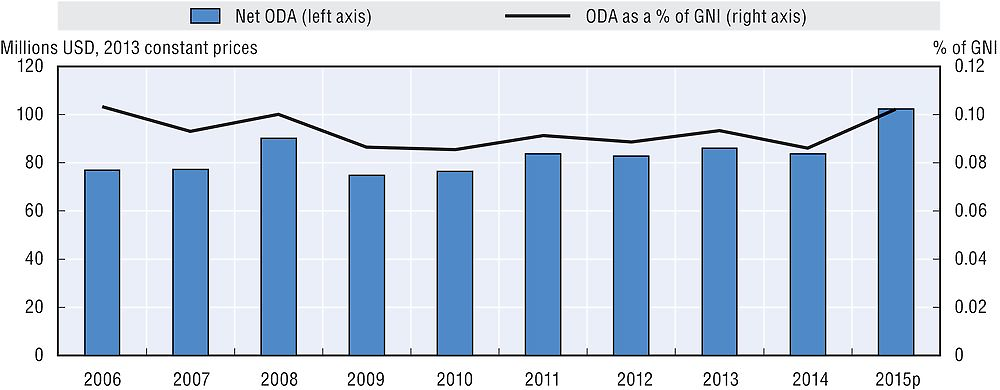
Development challenges as investment and business opportunities: The Slovak Republic’s policy and practices
The Slovak Republic aims to mobilise private financial resources to strengthen its development activities, to help establish Slovak entrepreneurs in priority developing countries, and to strengthen and expand the activities and development impact of Slovak businesses which are already active in priority countries. It launched a Development Meisters initiative in 2015, focused on increasing the capacities and skills of Slovak entrepreneurs to succeed in development business.
The Business Partnership programme – one of the eight main programmes of Slovak Development Co-operation – aims to find synergies between Slovak development co-operation and the business sector in partner countries. The programme focuses on strengthening the socio-economic development of local communities and mobilising private financial resources for development. The programme helps establish partnerships with local business entities in partner countries to strengthen their capacities while helping Slovak entities access new markets – without providing export subsidies.
The Slovak Republic allocated EUR 2 million of its ODA to private sector development through the European Bank for Reconstruction and Development in 2014 and EUR 1 million through the International Finance Corporation in 2015.
The Slovak Republic uses ODA to mobilise other resources for sustainable development
-
The Slovak Republic contributes to the mobilisation of domestic resources in developing countries by supporting initiatives to strengthen the tax systems of its partner countries (e.g. via knowledge transfer) as well as by supporting co-ordinated EU efforts in this area. It joined the Addis Tax Initiative (ATI) in December 2015. In 2013-15, the Slovak Republic supported the OECD/G20 Base Erosion and Profit Shifting (BEPS) project through contributions in the amount of EUR 30 000.
-
It promotes aid for trade to improve developing countries’ trade performance and integration into the world economy. It committed USD 1 million to trade-related activities in 2014 (7.5% of its bilateral allocable ODA).
The Slovak Republic’s official development assistance
In 2014, 19.7% of the Slovak Republic’s ODA was provided bilaterally, while 80.3% of total ODA was allocated as core contributions to multilateral organisations (well above the DAC country average of 28.3%). The major share of its multilateral aid (89%) went to fulfil its assessed contribution to the EU (including the European Development Fund). It also contributed to several other international organisations, notably the European Investment Bank, the United Nations system and the World Bank Group. In addition, it channelled 21.9% of its bilateral ODA to specific projects implemented by multilateral organisations (multi-bi/non-core contributions).
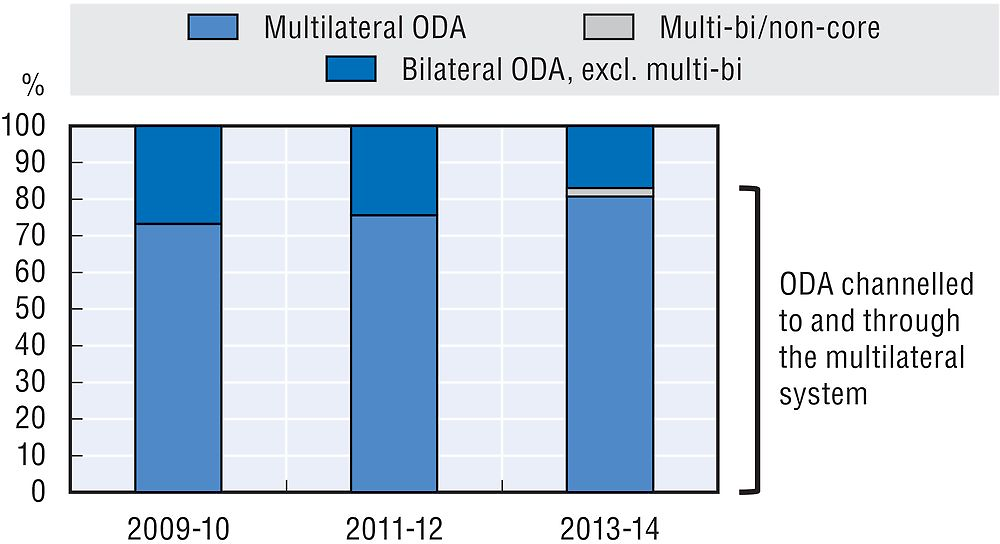
In 2014, 51% of bilateral ODA was programmed at partner country level. Its share of country programmable aid (CPA) was slightly below the DAC country average (52.9%). Project-type interventions made up 40% of CPA. Twenty per cent of bilateral ODA was classified as “other and unallocated”.
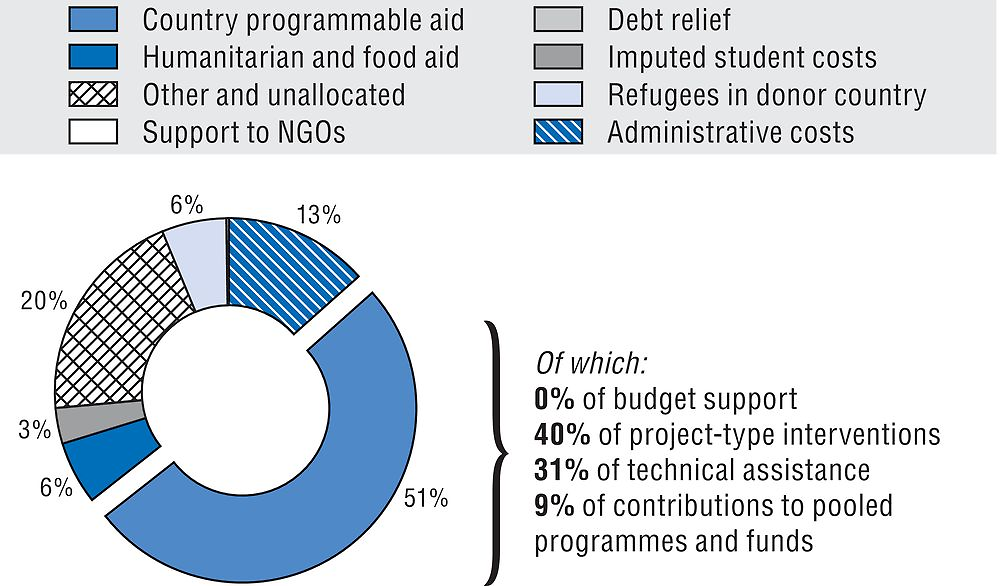
In 2014, USD 2.9 million of bilateral ODA was channelled to and through civil society organisations (CSOs). Slovak ODA to and through CSOs fell between 2013 and 2014, both in volume (-41.2%) and as a share of bilateral aid (from 30.6% to 17.6%). The DAC average was 17.4% in 2014.
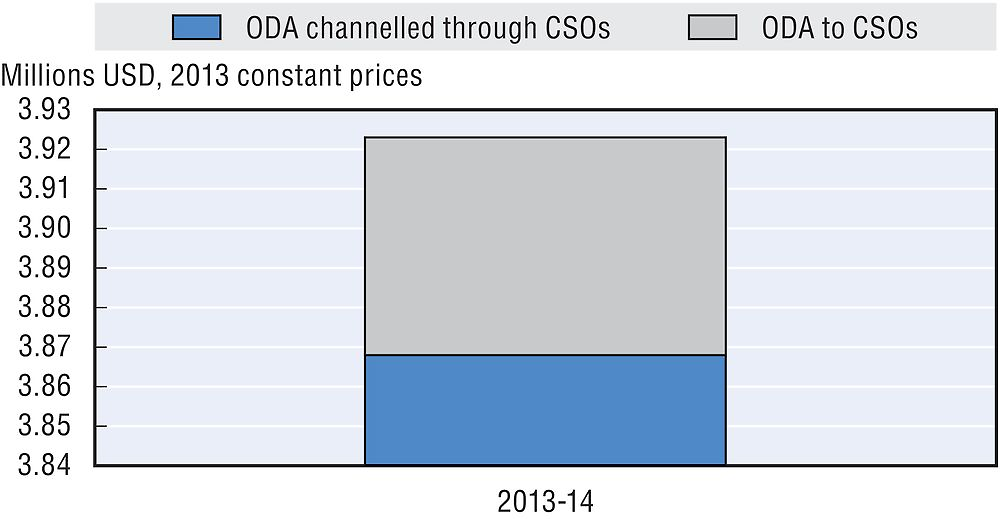
Bilateral ODA was primarily focused on Eastern Europe. In 2014, USD 5.5 million was allocated to Eastern Europe, USD 1.8 million to sub-Saharan Africa, and USD 1.1 million to south and central Asia.
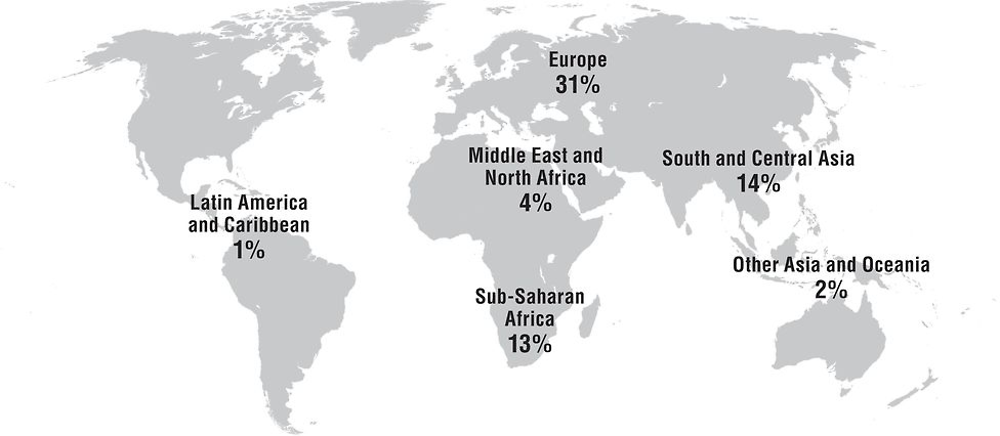
Note: 36% of bilateral ODA allocated was unspecified by region in 2013-14. This share is not represented on the map.
In 2014, 42.3% of bilateral ODA went to the Slovak Republic’s top 10 recipients. It focuses on ten priority partners, of which there are three programme countries (Afghanistan, Kenya, Moldova), six project countries (Albania, Belarus, Bosnia and Herzegovina, Georgia, Kosovo, Ukraine) and South Sudan. Nine priority countries are among its top 10 recipients. In 2014, its support to fragile states reached USD 3.6 million (22.1% of gross bilateral ODA).
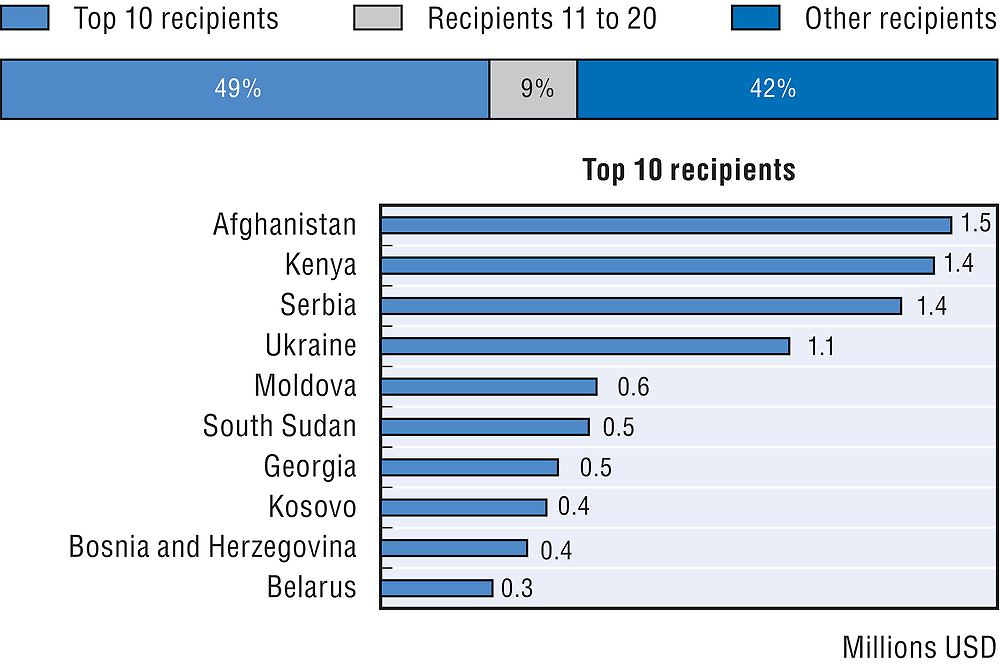
In 2014, 7.1% of bilateral ODA was allocated to least developed countries (LDCs), amounting to USD 1.2 million. This is a decrease from 20.6% in 2013, and is far lower than the 2014 DAC average of 25.6%. Upper middle-income countries received the highest share of bilateral ODA in 2014 (19.3%), noting that 47% of bilateral aid is unallocated by income group.
At 0.02% of GNI in 2014, total ODA to LDCs was far below the UN target of 0.15% of GNI.
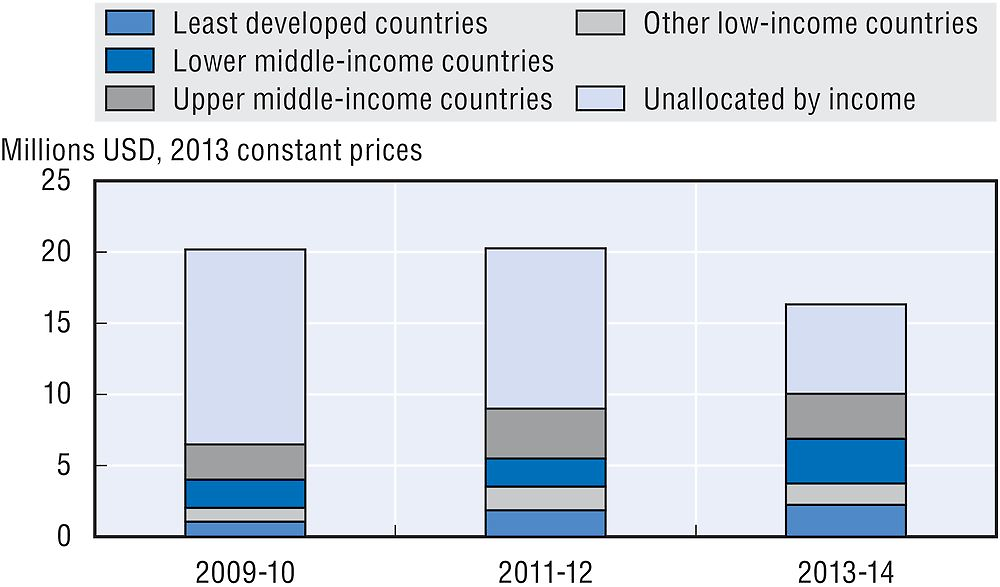
In 2014, 51% of bilateral ODA (USD 8.9 million) was allocated to social infrastructure and services, with a strong focus on education (USD 4.9 million) and support to government and civil society (USD 3.3 million). The Slovak Republic’s bilateral co-operation focuses on seven areas: education, healthcare, good governance and building of civil society, agriculture and forestry, water and sanitation, energy, and building a market environment. Priority sectors of engagement are identified in the country strategy papers for programme countries. The Slovak Republic will support sectors in its “project” countries on the basis of the diverse needs of the countries undergoing transformation and on the Slovak Republic’s own experience.

USD 0.3 million of bilateral ODA supported gender equality in 2014. The Slovak Republic considers that gender equality and women’s empowerment are crucial for eradicating poverty and promoting economic growth and social development. It plans to mainstream gender equality into its development co-operation programme. In 2014, 2.4% of Slovak bilateral allocable aid had gender equality and women’s empowerment as a principal or significant objective, compared with the DAC country average of 34.7%.
USD 1.4 million supported the environment in 2014. The Slovak Republic strives to integrate the environment and climate change into its development co-operation, in accordance with its commitments to mitigation, adaptation and protection of biodiversity. In 2014, 10.7% of its bilateral allocable aid supported the environment and 1.4% (USD 0.2 million) focused specifically on climate change, compared with the respective DAC country averages of 32.2% and 23.9%.
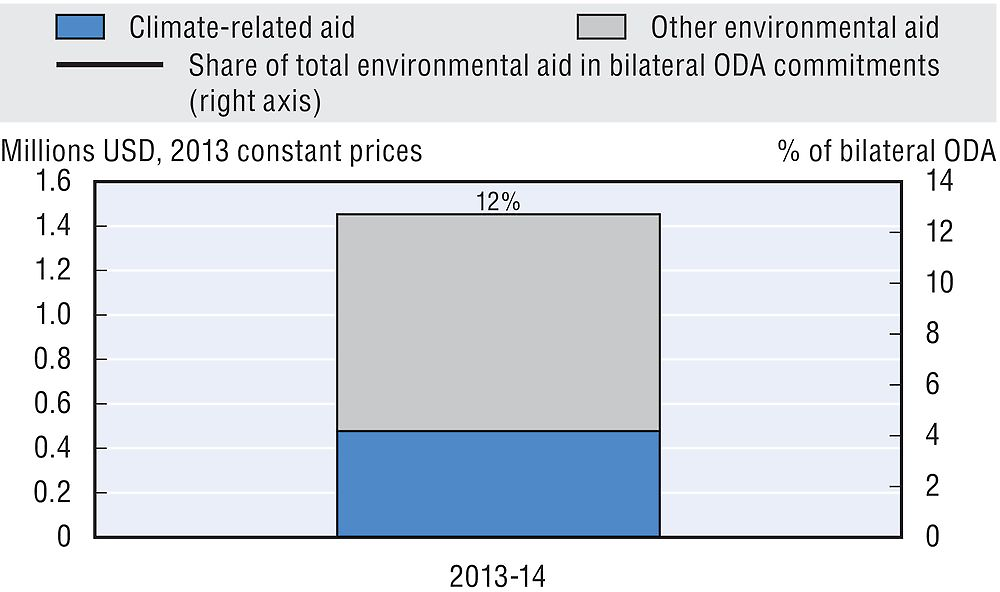
Note to reader: Annex B provides “Methodological notes on definitions and measurement for the Profiles of Development Assistance Committee members”.
